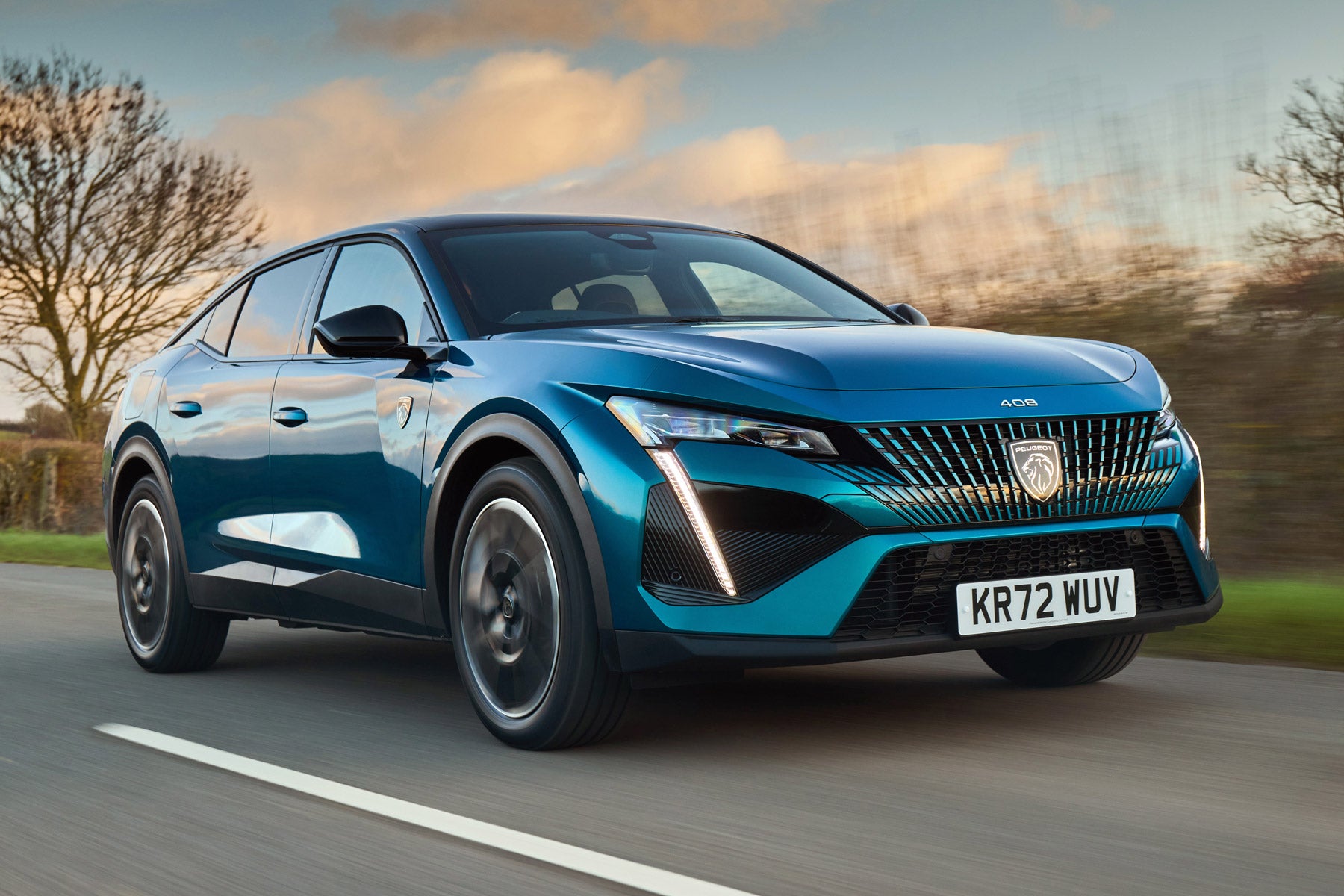Peugeot 408 Review 2024
Written by Andrew Brady
Quick overview
Pros
- Interesting alternative to generic family SUVs
- Available with plug-in hybrid model (while a pure-electric model is on its way)
- Classy and relatively spacious interior
Cons
- Many buyers will find a conventional SUV to be more versatile
- Heated seats only available as part of an expensive option pack
- You can soon spend quite a lot of money on a Peugeot 408
Overall verdict on the Peugeot 408
"The Peugeot 408 is a segment-spanning family car with impressive practicality, stylish design and efficient electrified powertrains. We're not entirely convinced buyers will be quick to trade in their versatile SUVs, but the Peugeot 408 certainly holds an element of left-field appeal."
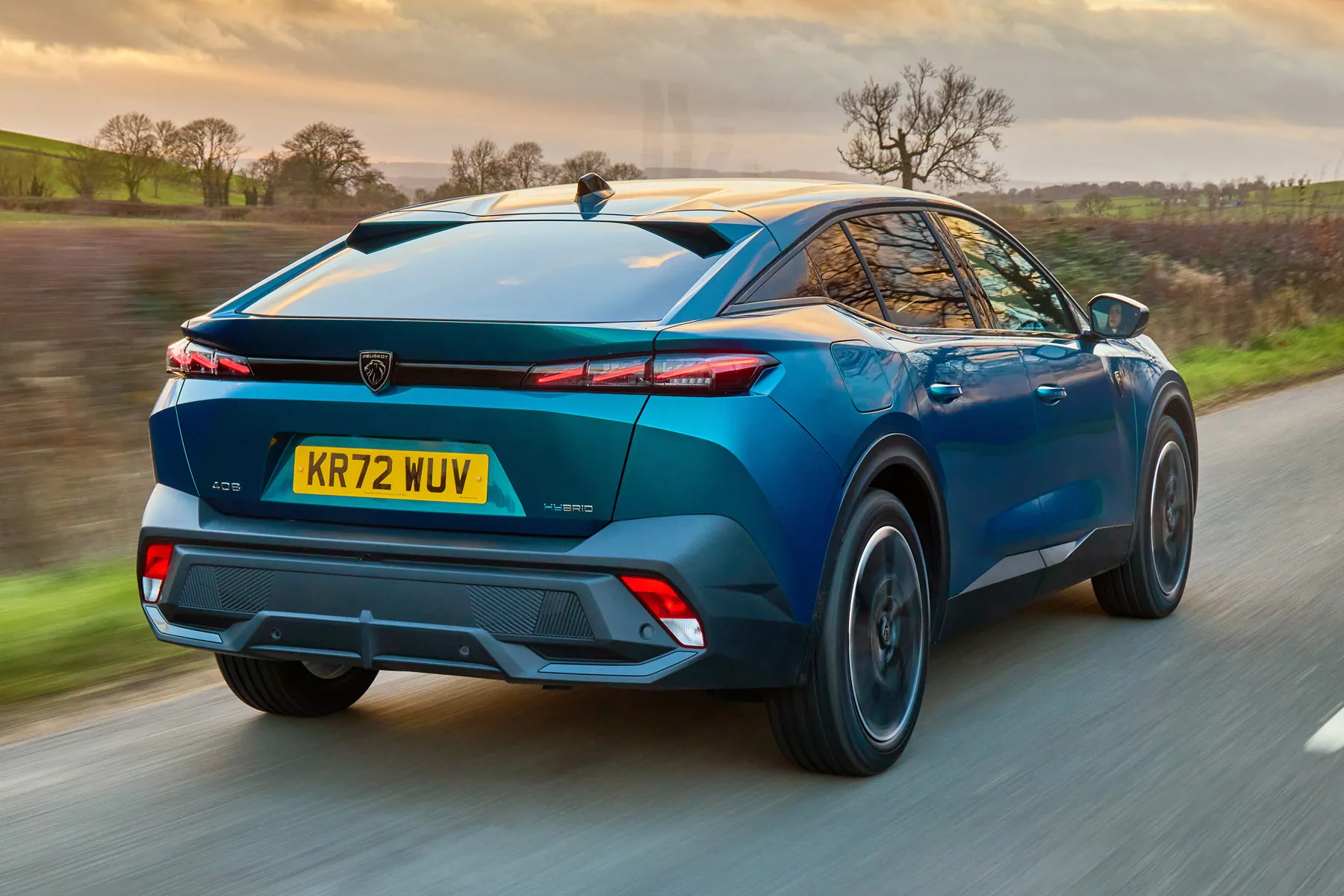
While the SUV market is huge, there's still a strong army of buyers who simply don't want something like a Volkswagen Tiguan or Range Rover Evoque. That might be because you don't like how they look, worry about the carbon footprint of so-called 'gas guzzlers', or maybe you just prefer to drive a car that's lower to the ground. If that sounds like you, read on for our full Peugeot 408 review.
The Peugeot 408 combines a lot of the best bits of an SUV with few of the compromises. That's the theory, anyway - it's basically a high-riding family car with a coupe roofline, meaning it looks a bit sportier than a traditional SUV and is also slightly more aerodynamic (which ought to be good news for efficiency). It takes a very similar approach to the Citroen C5 X - a car we rate highly for doing things a bit differently.
One of the biggest selling points of SUVs is the amount of interior space they offer. But the Peugeot 408 is actually quite a big car - it's got a larger footprint than a Peugeot 3008, and more space between the front and rear wheels. That means it feels surprisingly spacious inside, while you still sit higher than you would in a conventional family hatch. The boot is huge, too, although you might want to look at the more conventional Skoda Superb Estate if outright luggage capacity is a priority.
The interior feels quite posh, which is no surprise as Peugeot now pitches itself slightly above mainstream competitors like Ford and Vauxhall. You get the same tiny steering wheel as other Peugeot models - an acquired taste, as some drivers find it blocks their view of the digital dials.
A 10.0-inch infotainment system is fitted as standard, while there's quite a cool touch display with configurable 'i-Toggles' acting as shortcut buttons to things like your favourite radio station, phone contacts or adjusting the climate control. You also get a 10.0-inch main dash display.
In terms of trim levels, the Peugeot 408 was available in three key flavours: Allure, Allure Premium and top-spec GT, while a small number of range-topping Peugeot 408 First Edition models were also sold. It's now only offered as an Allure or GT. All Peugeot 408 models are well-equipped, although some of the desirable driver-assistance tech is reserved for higher spec models, while the swankiest exterior design details are only available on the 408 GT.
Buyers are also offered a choice of three different engines in the first instance, made up of one petrol (the Peugeot 408 Puretech 130) and three plug-in hybrids (badged the Hybrid 136, Hybrid 180, and Hybrid 225). If you can charge a car at home, we'd recommend one of the PHEVs - they have an electric-only range claimed at 34 miles, which means you can pop to the shops or take the kids to school without the petrol engine needing to kick in.
Looking for a used car for sale? We've got 100s of Peugeot Approved Used Cars for Sale for you to choose from, including a wide range of Peugeot 408s for sale.
Is the Peugeot 408 right for you?
If you're looking for a practical family car that very definitely isn't an SUV, the Peugeot 408 could be a great choice. It's more stylish than conventional estate cars while also being more practical than coupe-crossovers like the Cupra Formentor and Renault Arkana. The lack of a diesel engine won't be an issue for many buyers, while the Peugeot e-408 will be worth waiting for if you're seeking a left-field electric vehicle.
What’s the best Peugeot 408 model/engine to choose?
It's hard to overlook the entry-level 1.2-litre Puretech petrol engine. You might think a car needs hybrid power (at the very least) to be competitive nowadays, but actually the most affordable 408 is peppy enough for driving out of town while the standard automatic gearbox makes for relaxed cruising.
The least powerful hybrid model is the Hybrid 136 e-DSC6 that is at the mild end of the scale, so it does not plug-in to charge. Instead, it recharges only through regenerative braking. Some might sniff at this, but then it's also significantly cheaper than its PHEV sister models.
If you can charge a car at home, though, and the idea of setting off in silence appeals, look at one of the plug-in hybrid models. We've only driven the Peugeot 408 Hybrid 225 so far but, actually, the less powerful Hybrid 180 might make more sense - it's more affordable, just as efficient and barely any slower than the range-topper.
In terms of trim levels, all Peugeot 408 models are fairly well equipped. Even the entry-level Peugeot 408 Allure comes with a 10-inch touchscreen infotainment system, for example, as well a 10-inch digital driver's display and 360-degree parking cameras. Upgrade to the Peugeot 408 GT is the poshest of the range - with a heated steering wheel as standard, a smart electric tailgate, customisable ambient lighting, Alcantara and faux-leather trim as well as sporty 19-inch alloy wheels. It also has added safety kit with SOS assistance, and lane positioning assist.
What other cars are similar to the Peugeot 408?
The only clear competitor for the Peugeot 408 is the Citroen C5 X. It shares a platform and engines with the Peugeot, as well as its slightly alternative segment-spanning approach. The Peugeot is pitched slightly above the Citroen in terms of interior quality (and price tag), but we'd suggest looking at both and deciding which one you like the most.
Otherwise, there are an array of 'not quite the same but similar' competitors. You might want to look at stylish estate cars like the Volkswagen Arteon Shooting Brake or slightly smaller Mercedes CLA Shooting Brake. It's also up against coupe-SUVs like the Renault Arkana and Cupra Formentor, not to mention premium alternatives like the Audi Q3 Sportback (and bigger Audi Q5 Sportback) as well as the BMW X2 and Range Rover Evoque.
If you're looking for a sensible (and practical) family SUV, we'd suggest a Kia Sportage, Hyundai Tucson, Volkswagen Tiguan, Skoda Karoq or Mazda CX-5.
Comfort and design: Peugeot 408 interior
"The Peugeot 408 is a cut above mainstream competitors in terms of perceived quality. It feels pleasantly upmarket inside, while its angular dashboard and smart infotainment setup give it a dose of the wow factor."
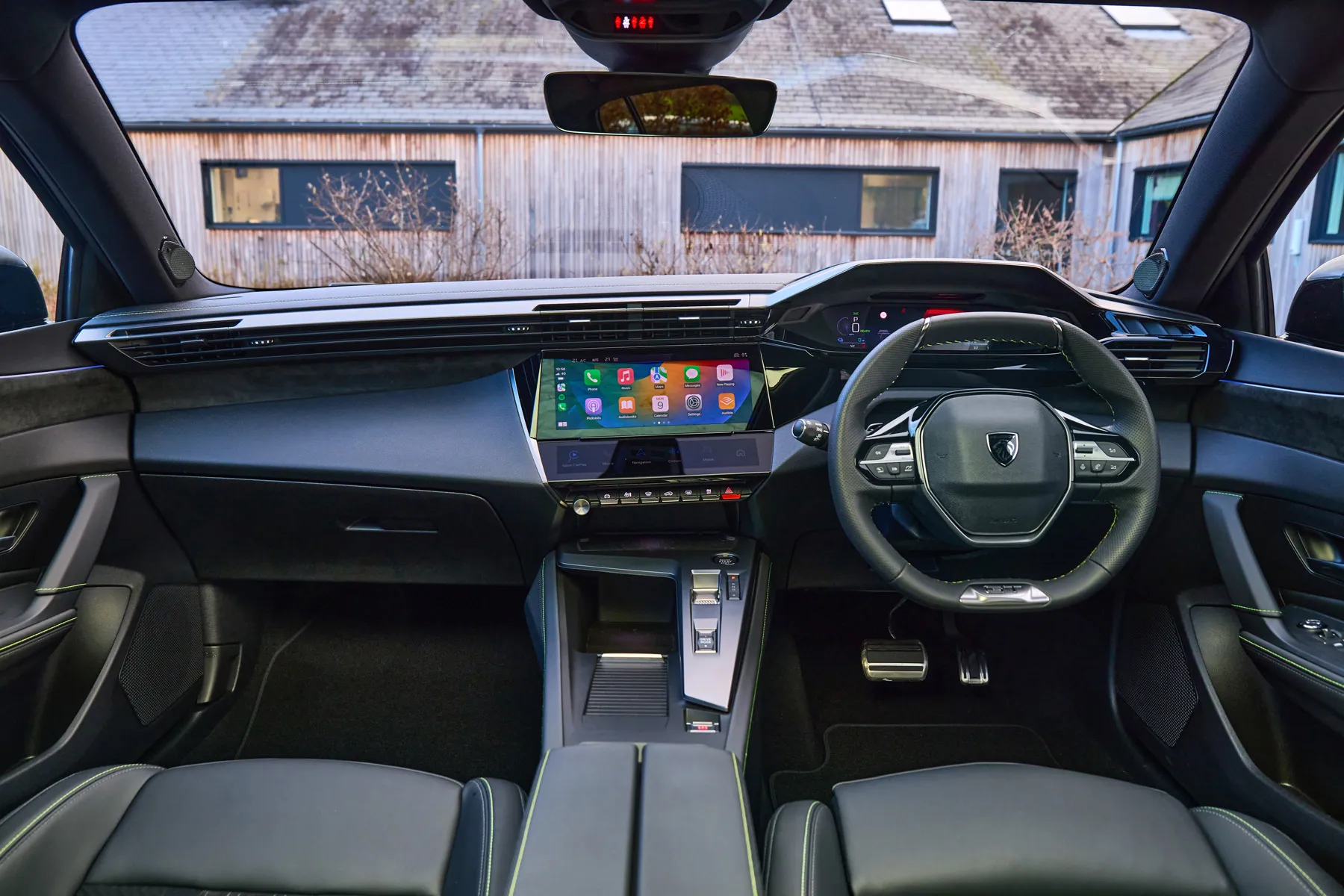
The Peugeot 408's cabin looks and feels pretty smart, with a welcome use of high-quality materials and not too many glossy fingerprint-attracting finishes. Pleasingly, you don't have to spend top dollar on one of the most expensive trim levels for maximum plushness in your 408, either. The entry-level Peugeot 408 Allure comes with leather-effect trim on the seats, manual lumbar adjustment on the driver's seat, interior ambient lighting (linked to whichever drive mode you're in) and a 10-inch navigation system with voice recognition and over-the-air updates.
If you do hunt out a top-spec Peugeot 408 GT, though, you get the same kind of features you'd expect in an alternative from an established premium brand. These include a frameless rear-view mirror, luxury carpet mats, vanity mirrors with LED lighting in the sunvisors, part-Alcantara seats and ambient lighting that can be customised to your tastes.
We found it easy to get comfortable in our Peugeot 408 test car, with a noticeably higher seating position than you'd get in a conventional estate car like the Volkswagen Passat (and the smaller Peugeot 308 hatchback, for that matter). You're not going to be looking down at other drivers, though - you'll need a 'proper' SUV like the Volvo XC40 for that.
One little bugbear we do have about the Peugeot 408's interior is that you need to spec the expensive Driver and Passenger Seat pack for heated front seats (also adding electric adjustment and a desirable - if slightly unnecessary - massage feature). This is only available on the Peugeot 408 GT so, if you buy a lower-spec model, you'll have no choice but to make do with a cold behind.
Quality and finish
Stellantis (the supergroup that owns Peugeot, Vauxhall and Citroen - to name a few) wants Peugeot to move upmarket in a bid to seperate itself from the more mainstream brands in its arsenal. That's reflected in the cabin of the Peugeot 408 - everything you touch feels well-finished, and there's even a pleasing 'thud' as you close the doors. We have little doubt that it'll still look fresh a few years' down the line, too, helped by family-friendly wipe-clean surfaces and a hard plastics where you need them (such as low down in the footwells).
Infotainment: Touchscreen, USB, nav and stereo in the Peugeot 408
The Peugeot 408 defies fashion in many ways - one being the location of the infotainment screen. We're increasingly seeing digital displays perched on top of the dashboard like a bit of an afterthought (admittedly in a useful position for following sat-nav directions), but the Peugeot 408 uses what the brand describes as a 'high vent' architecture. That means the vents are placed above the navigation display, directed towards the occupants' heads.
The 10.0-inch navigation display (which is standard across the Peugeot 408 range) is incorporated neatly into the dashboard, positioned slightly lower down and angled towards the driver (reducing unwanted reflections and generally making it easier to use). It's a fairly slick system, while Apple CarPlay and Android Auto are on hand to provide easy access to your favourite phone apps.
Below the central display is a touchscreen panel with customisable shortcuts. It works well and is relatively easy to operate on the move, although we'd still prefer a bank of traditional buttons.
Behind the steering wheel is a digital display, which looks clear enough although top-spec Peugeot 408 GT models come with a 3D effect. Maybe it's just our tester's eyes, but we found this hard to focus on compared to the standard screen.
Space and practicality: Peugeot 408 boot space
If you're trying to pigeonhole the Peugeot 408, it's worth taking its dimensions into account. It measures 4687mm in length, 2062mm in width and 1478mm in height. Its wheelbase (that's the space between the front and rear wheels) measures 2787mm. To put that into context, the Peugeot 408 is slightly larger in all dimensions than the Peugeot 308 SW, but shorter than a Skoda Superb Estate.
It's quite a long car, and that's good news for passenger space. You certainly won't find the front seats lacking in roominess, while adults should be fairly comfortable in the back (although the sloping roofline does mean headroom takes a slight hit). There's nothing particularly special about the rear seats - they don't slide or recline, while kids will argue about who has to sit in the narrow middle seat.
The boot's capable of carrying up to 536-litres of luggage, although a chunk of that is underfloor storage. That means plug-in hybrid Peugeot 408 models aren't quite as capacious - their batteries eat into that useful extra stowage space, so their capacity drops to 471-litres.
If you need more room, there are levers in the boot for dropping the rear seats. They split 60:40 and there's up to 1611-litres of luggage space with them dropped (1545 in hybrid models). Access to the boot is easy, although we still reckon you'd be better with a family SUV like the Skoda Kodiaq if you need a lot of interior space.
Handling and ride quality: What is the Peugeot 408 like to drive?
"The Peugeot 408 errs on the side of comfort, although it does feel a trifle sportier than the Citroen C5 X. We wonder how much of that is down to the tiny steering wheel, which provides instant reactions to the lightest of inputs..."
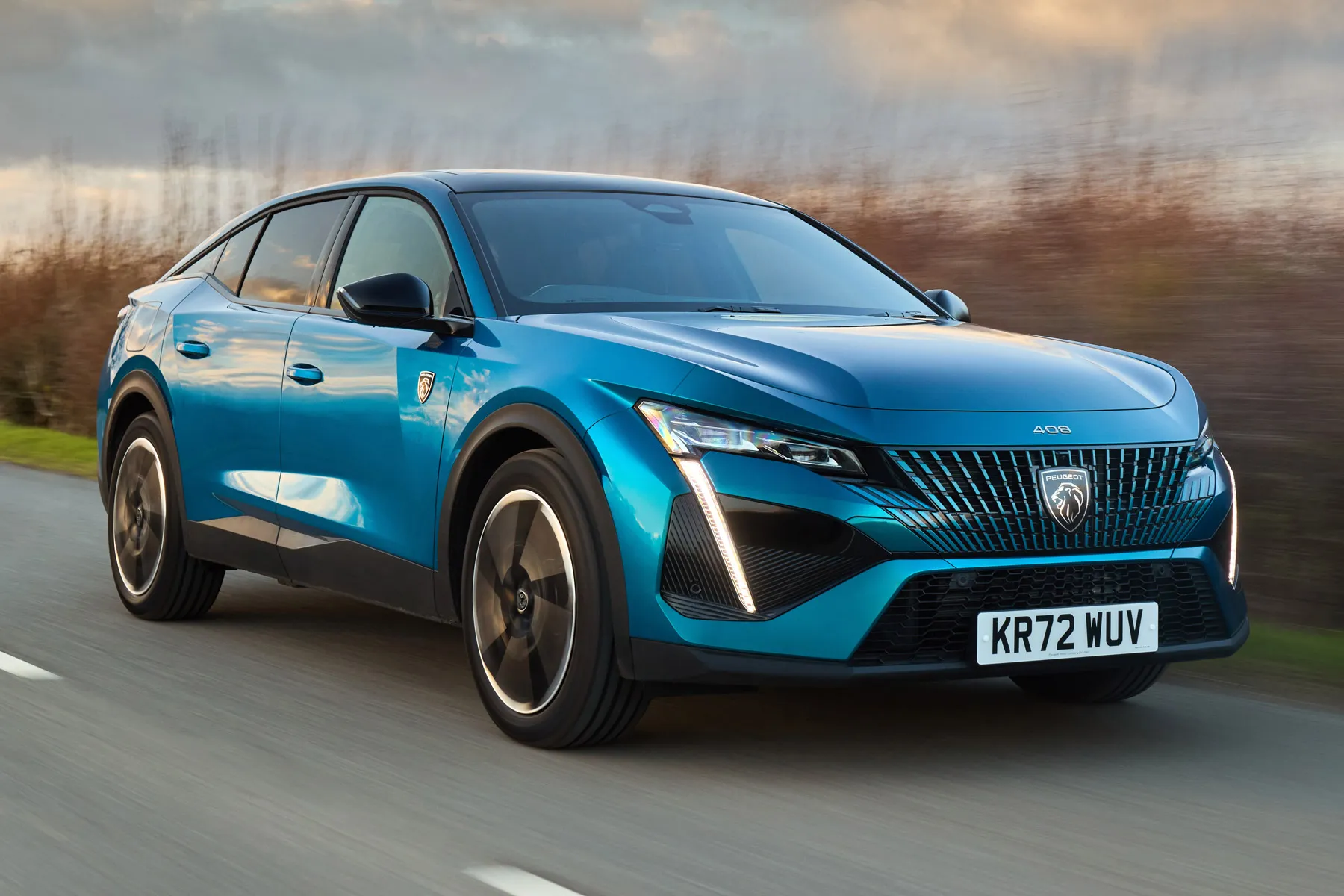
In theory, the Peugeot 408 should strike a perfect balance between comfort and sportiness. Its higher ride height and soft suspension mean you won't be feeling every bump in the road, while its lower roofline (and therefore reduced centre of gravity) means it won't be lollopping around bends.
That's kinda the case in practice, although we wouldn't say it's as fun to drive as a Cupra Formentor. It feels agile, but the steering is too light for any real fun. And the hybrid models are heavy, thanks to their large battery packs, so you soon become aware of the 408's mass if you try to hustle it along.
Visibility is decent enough whether you're negotiating city streets or changing lanes on a congested motorway, while there's plenty of tech available to take some of the strain out of day-to-day driving (see our safety section below for the full rundown).
If you're looking for a car which prioritises comfort, we'd recommend looking for a petrol 408 - ideally one with the smaller alloy wheels fitted to lower-spec models. Or, even better, take a look at the Citroen C5 X.
What engines and gearboxes are available in the Peugeot 408?
Buy a Peugeot 408 and you'll get a choice of petrol, mild hybrid, or plug-in hybrid power, while an all-electric Peugeot e-408 is set to follow.
The petrol Peugeot 408 uses the brand's popular 1.2-litre Puretech engine, which sounds a little weedy in a car of this size. With 130PS on tap, it might feel underwhelming if you're used to a torquey turbodiesel, but it punches above its weight. Officially it'll accelerate to 62mph in 10.4 seconds, while the eight-speed automatic gearbox (fitted as standard) changes gears smoothly and doesn't hamper progress. You can't get the Peugeot 408 with a manual gearbox, which is no bad thing in our opinion.
The mild hybrid version of the 408 is called the Hybrid 136 e-DSC6 and uses the petrol 1.2-litre motor with a little electrical assistance. It offers a reasonable pep in its step, but without the EV range of the other hybrids, it's hard to see its appeal over and above the non-hybrid, and cheaper, 1.2 model.
There is a choice of two different plug-in hybrids available in the Peugeot 408, too. Both use a 1.6-litre petrol engine paired with an electric motor and a 12.4kWh battery pack. The Peugeot 408 Hybrid 180 produces 180PS while the Hybrid 225 packs, you guessed it, 225PS. The former covers 0-62mph in 8.1 seconds while the latter takes 7.8 seconds - not that much quicker considering its higher power output and premium price tag.
We've driven the more powerful Peugeot 408 Hybrid 225 and it's adequately quick, although not exactly sporty in its delivery. Like most PHEVs, the Hybrid 225 is at its best driving around town with a fully-charged battery. If you're too heavy with the throttle, you'll notice a slight hesitation as the petrol engine roars into life. If you can charge a car at home and aren't completely averse to pure-electric vehicles, we'd consider waiting for the Peugeot e-408.
Refinement and noise levels
Generally, the Peugeot 408 is very refined - with little in the way of irritating wind or road noise to upset the serenity of the cabin. As we touched on above, you'll notice a bit of a noise as the petrol kicks in on plug-in hybrid models, but that's preferable to a grumbly diesel engine.
Safety equipment: How safe is the Peugeot 408?
Anything less than a five-star Euro NCAP safety rating will raise eyebrows these days, so it's surprising that the Peugeot 408 was awarded just four stars when it was crash-tested by the independent body in 2022. It's not fundamentally an unsafe car, though - just like the smaller Peugeot 308, it lost points for the marginal performance of its autonomous emergency braking system.
You do at least get lots of driver-assist and safety technology as standard, though. A lane-keep assist feature will nudge the steering if you start to inadvertently leave your lane, while a driver attention alert system will tell you when you need a break. An advanced emergency braking system uses cameras to detect a potential collision and mitigate a potential crash, while hybrid models also get radar systems acting as a second pair of eyes. The Drive Assist Pack which adds rear cross traffic alert, adaptive cruise control and long range blind spot detection is an option for the Allure, while the GT gets SOS call assist and lane positioning assistance as standard. The GT can be upgraded with the Drive Assist Pack Plus.
MPG and fuel costs: What does a Peugeot 408 cost to run?
"The hybrid models are the economy champions of the Peugeot 408 range. Make sure you regularly charge them - if you do, the petrol engine might barely have to kick in and you could see almost unbelievable fuel economy."
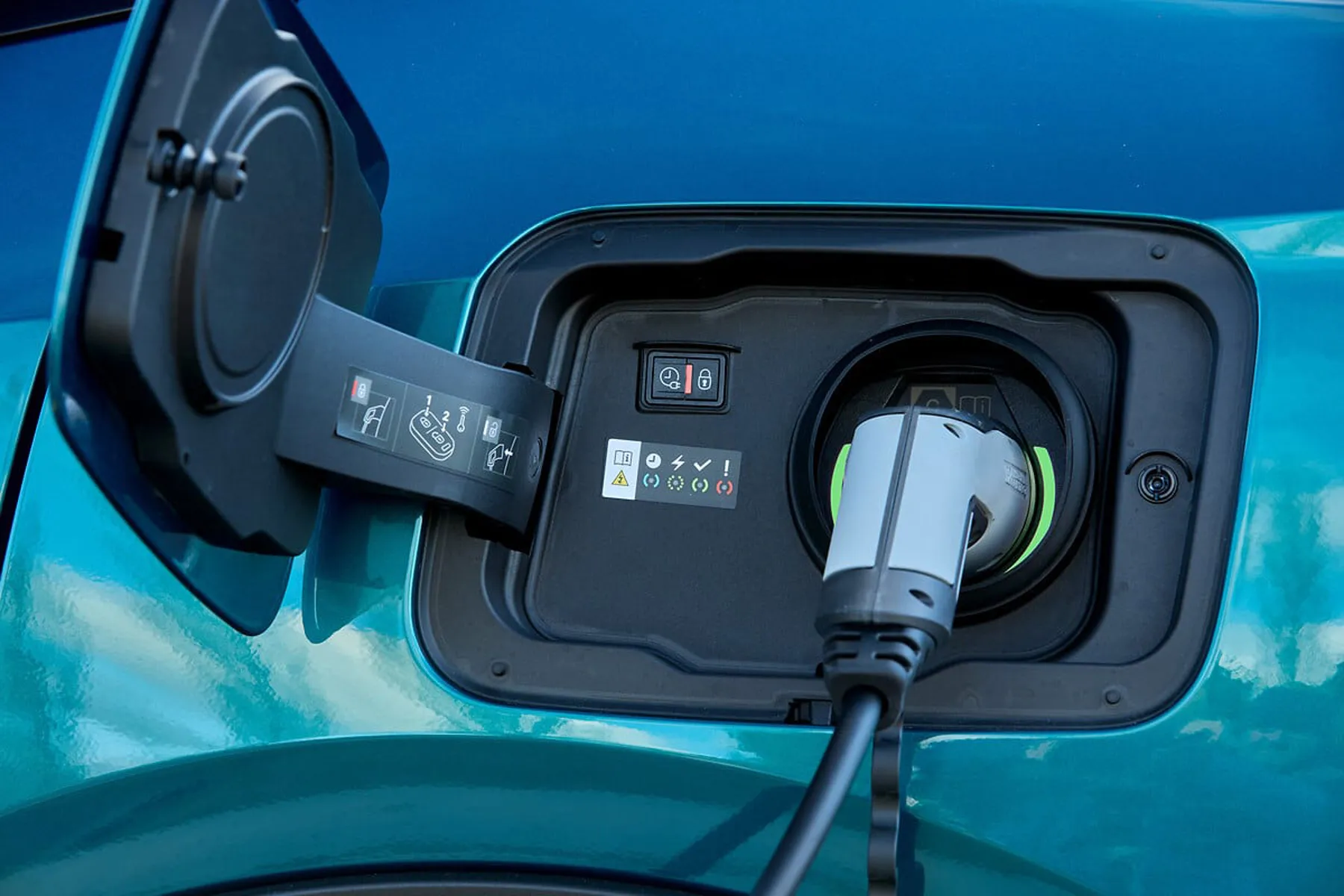
Both the Peugeot 408 Hybrid 180 and Hybrid 225 have an official electric range of 34 miles according to official figures. That might not sound like a significant amount compared to pure-electric alternatives like the Volkswagen ID.5 but, if you have a relatively short commute or use the car for picking the kids up from school, it might mean you'll barely get through any petrol at all. According to WLTP tests, hybrid versions of the Peugeot 408 manage around 230mpg - take that figure with a pinch of salt unless you rarely drive it with a flat battery, though.
Plug either of the Peugeot 408 hybrid models into a 7.4kW home wallbox and they'll be fully charged in around three and a half hours (or just an hour and 40 minutes if you spec the optional 7.4kW on-board charger). Depending on your home electricity tariff, you'll be paying not a lot to charge the Peugeot 408.
If you don't want the faff of charging, the regular Peugeot 408 1.2-litre Puretech or the Hybrid 136 e-DSC6 mild hybrid should be relatively frugal. It petrol-only car will officially return up to 48.1mpg - although, like a lot of small turbocharged petrol engines used in big cars, that'll soon drop if you're heavy with the accelerator pedal. The mild hybrid claims up to 58.8mpg.
How reliable is the Peugeot 408?
The Peugeot 408 shares a lot of parts with other Stellantis Group products so maintenance costs should be relatively low. The Peugeot 408 comes with a three-year warranty, while the traction battery in hybrid models is covered for up to eight years/100,000 miles.
Insurance groups and costs
Petrol Peugeot 408 models should be fairly cheap to insure, sitting in insurance groups 19-21 depending on spec. You might pay a bit more to insure a hybrid model, particularly if you're a new driver, with the PHEVs placed in insurance groups 28 to 31.
As ever, we'd recommend shopping around for an accurate quote rather than relying too much on insurance groups. Circumstances such as your age, driving experience, location and annual mileage will all have an effect on how much the Peugeot 408 costs to insure.
VED car tax: What is the annual road tax on a Peugeot 408?
While the first road tax payment is lumped into the on-the-road price when the car is new (so it's pretty much irrelevant, especially if you're buying a secondhand Peugeot 408), the annual tax payment from year two onwards depends on which engine you choose and even how much the car cost when it was first registered.
All petrol and diesel cars (including the Peugeot 408 1.2 Puretech) are taxed at a flat rate of £190 a year. The hybrid 408 models get a £10/year discount on that as they're classed as 'alternatively-fuelled', so that's an annual tax bill of £180. There's a 'but' coming - all cars with a list price of more than £40,000 when new (that's nearly all the PHEV models) are hit with an extra £410/year premium car surcharge from years two to six.
How much should you be paying for a used Peugeot 408?
"A new Peugeot 408 is priced from around £32,000 with the petrol engine, while the plug-in hybrid is closer to £40,500 as a starting point.
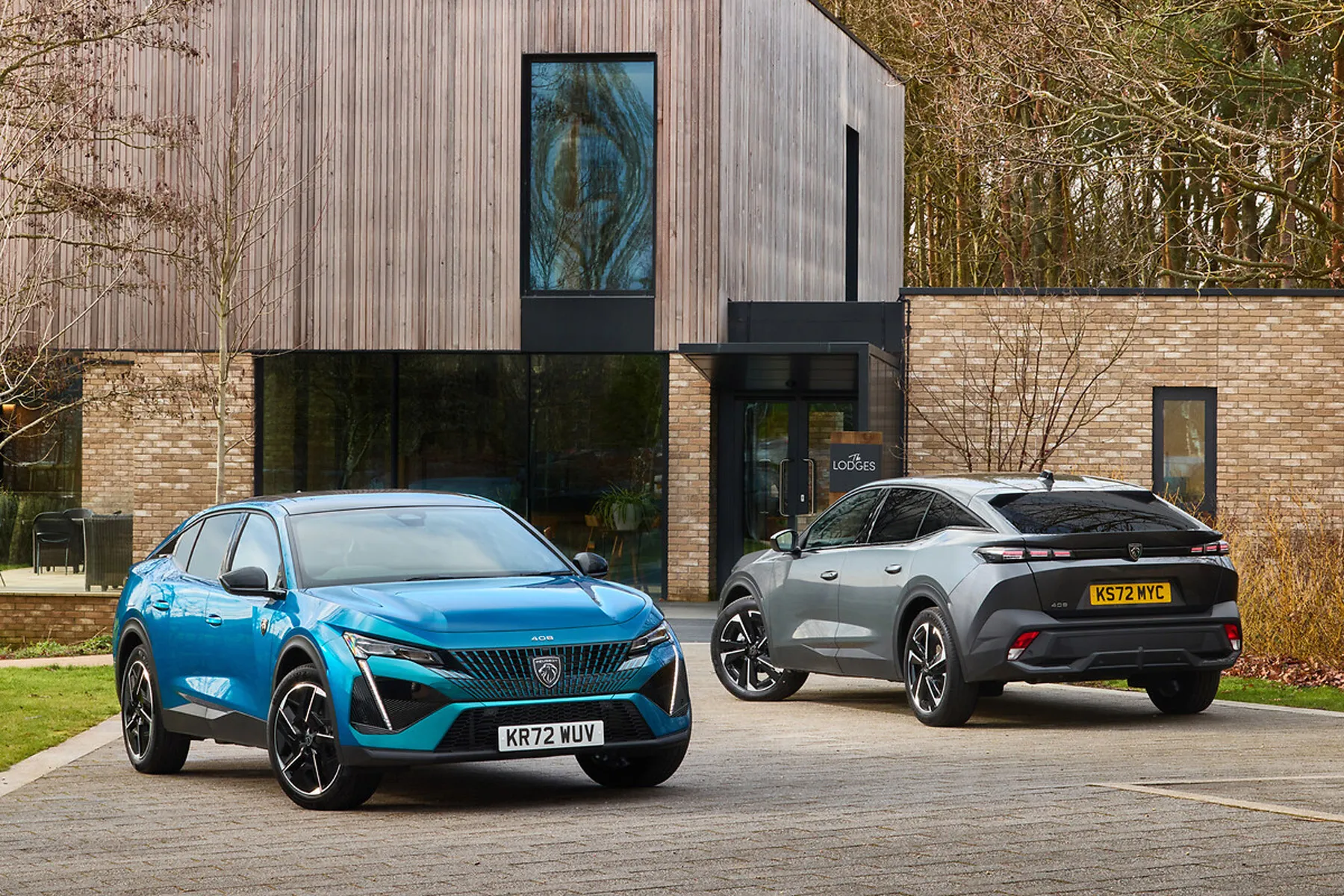
You'll pay a premium of around £2000 or so for a Peugeot 408 over the equivalent Citroen C5 X - not surprising considering the brand's slightly upmarket positioning.
Not that the Peugeot 408 is particularly expensive. It's more affordable than the Volkswagen Arteon Shooting Brake (and you get more for your money in terms of standard equipment), while it significantly undercuts more conventional premium SUV alternatives like the Audi Q5 Sportback and BMW X4.
If you want to skip the queue (and save cash in the process), we'd recommend looking for a pre-registered Peugeot 408. These are cars with delivery miles on the clock that have been delivered to dealers and often used as demonstrator models. We have seen dealers offering as much as £2700 off as-new Peugeot 408s.
Trim levels and standard equipment
From launch, the new Peugeot 408 was available in four trims: Allure, Allure Premium, GT, and First Edition.
The Peugeot 408 Allure comes with 17-inch alloy wheels, LED headlights with ‘Smartbeam’ assist, as well as a front grille with horizontal chrome accents. Inside, the 408 Allure comes with fabric seats combined with leather-effect trim, as well as ambient lighting. The Allure also comes with a 180-degree colour reversing camera, rear parking sensors and connected navigation. Advanced emergency braking is standard, as well as extended traffic sign recognition.
Upgrade to a Peugeot 408 Allure Premium when buying used and you'll get 19-inch diamond-cut alloy wheels. Keyless entry is standard, as well as an Advanced Emergency Braking system with video camera and radar technology. Allure Premium models also offer front parking sensors as well as the Drive Assist Pack which adds rear cross traffic alert, adaptive cruise control with stop & go as well as long range blind spot detection.
Topping the range, the Peugeot 408 GT comes with unique 'Graphite' diamond-cut alloy wheels as well as the brand's Lion shield presented on the front doors. The front grille is also different, featuring body-coloured vertile accents. Inside, GT models come with aluminium door and boot sill trims, while ambient lighting with eight colour choices is also standard. A heated leather steering wheel with green stitching and ‘GT’ badging adds to comfort and styling. Technology upgrades include the 10-inch instrument panel display featuring 3D technology, while ‘Clean Cabin’ Technology improves air quality. A Driver Sport Pack adds steering, throttle and gearbox modes which enhance feedback and response, while the engine sound can also be digitally enhanced. Peugeot SOS & assistance and lane positioning assist improve safety and driver convenience.
Limited edition Peugeot 408 First Edition models are now sold out but come with 20-inch diamond-cut alloy wheels finished in matte onyx black and the upgraded 7.4kW on-board charger. Inside First Edition models come with Peugeot's ‘Seat Pack’ which adds an AGR-certified 10-way electrically adjustable driver’s seat for optimal comfort. Front passenger seat is upgraded to a six-way electrically adjustable seat, with both driver and passenger seats featuring heated and massage functions.
The range was slimmed down to just the Allure and GT trims in the middle of 2024.
Ask the heycar experts: common questions
What is the Peugeot 408?
What is the range of the Peugeot 408 plug-in hybrid?
How much is a Peugeot 408?
Get our latest advice, news and offers
Keep me updated by email with the latest advice, news and offers from heycar.
By submitting you agree to our privacy policy
